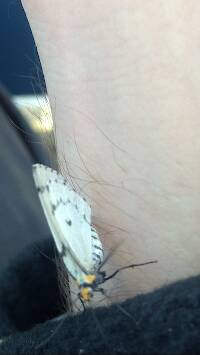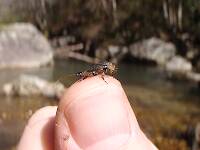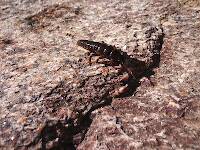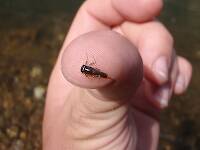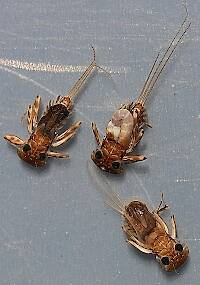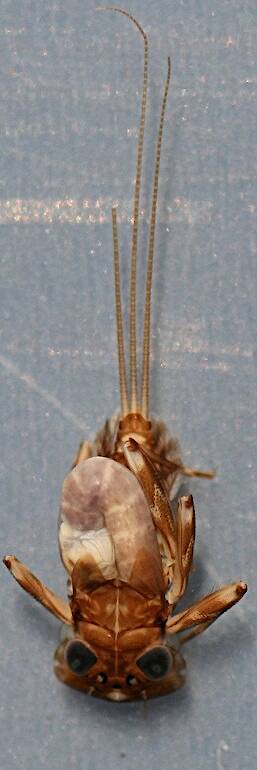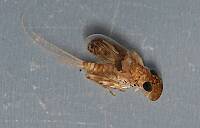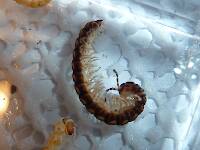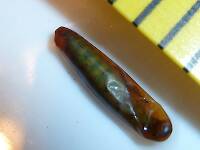
Hex Mayflies
Hexagenia limbata
The famous nocturnal Hex hatch of the Midwest (and a few other lucky locations) stirs to the surface mythically large brown trout that only touch streamers for the rest of the year.
Featured on the forum

This one seems to tentatively key to Holocentropus, although I can't make out the anal spines in Couplet 7 of the Key to Genera of Polycentropodidae Larvae nor the dark bands in Couplet 4 of the Key to Genera of Polycentropodidae Larvae, making me wonder if I went wrong somewhere in keying it out. I don't see where that could have happened, though. It might also be that it's a very immature larva and doesn't possess all the identifying characteristics in the key yet. If Holocentropus is correct, then Holocentropus flavus and Holocentropus interruptus are the two likely possibilities based on range, but I was not able to find a description of their larvae.

Troutnut is a project started in 2003 by salmonid ecologist Jason "Troutnut" Neuswanger to help anglers and
fly tyers unabashedly embrace the entomological side of the sport. Learn more about Troutnut or
support the project for an enhanced experience here.
Shawnny3 on Jul 15, 2009July 15th, 2009, 12:37 pm EDT
When we were overrun by the disgusting little buggers last year, I thought about tying up an imitation, but several people told me that they are toxic to trout and that trout won't feed on them. Then last week I happened upon a sentence in a flyfishing book by Dave Wolf in which he states that an outbreak of gypsy moths can produce excellent fishing. So which is it? Do the trout treat the caterpillars and moths differently? As much trouble as they cause, it would be a nice change to benefit in some way from a bad outbreak of them.
-Shawn
-Shawn
Jewelry-Quality Artistic Salmon Flies, by Shawn Davis
www.davisflydesigns.com
www.davisflydesigns.com
Dsdubmon1
Posts: 2
Posts: 2
Dsdubmon1 on Jul 16, 2009July 16th, 2009, 9:20 pm EDT
tie on mon"all fish" eat gypsy moths and the caterpillars. done it, its a gas!!
Jmd123 on Jul 22, 2009July 22nd, 2009, 3:24 pm EDT
Some years ago my father and I paid a non-fishing visit to one of my favorite places - the Maple River (Emmet Co., MI), where I had learned to fly-fish only a few years before. We noticed a nest of tent caterpillars on a small cherry tree overhanging the bank. I decided to rip open the nest and dump the caterpillars into the water. A few seconds later I heard a big splash just downstream under some alder bushes! As they seem to float, at least initially, I would try some dry variant of the Woolly Worm in appropriate colors and sizes. I think that trout, and fish in general, will take advantage of any food source that becomes highly abundant and easy to eat. I've seen bluegill in the Huron River (Ann Arbor, MI) go crazy during flying ant falls, making the water look like it's boiling.
BTW, I am an entomologist (M.S. Michigan State University, 1991), and I have never heard anything about gypsy moths or their larvae being toxic to anything! I think just about everything in the vertebrate world will gobble them when they are abundant. They don't seem to feed on anything toxic where they could sequester toxins like insects that feed on milkweed (e.g., Monarch butterfly caterpillars).
Go for it!!!
Jonathon
BTW, I am an entomologist (M.S. Michigan State University, 1991), and I have never heard anything about gypsy moths or their larvae being toxic to anything! I think just about everything in the vertebrate world will gobble them when they are abundant. They don't seem to feed on anything toxic where they could sequester toxins like insects that feed on milkweed (e.g., Monarch butterfly caterpillars).
Go for it!!!
Jonathon
No matter how big the one you just caught is, there's always a bigger one out there somewhere...
Shawnny3 on Jul 23, 2009July 23rd, 2009, 1:10 am EDT
Thank you, guys. I wonder if the opinion that they're toxic comes from the allergic reactions some people have to them when they touch them. Last year I was at the cusp of sitting down and developing a tie for them when I "learned" that they were toxic and desisted. They were as thick last year as I've seen them since I was a little kid, and I never fished them a single time. Now I'm a little annoyed - that's what I get for listening to people. That won't happen again!
I was thinking the same thing, Jonathon, some kind of woolly worm variation that could be fished wet or dry. Next time they're thick I won't be without something in my box, that's for sure.
-Shawn
I was thinking the same thing, Jonathon, some kind of woolly worm variation that could be fished wet or dry. Next time they're thick I won't be without something in my box, that's for sure.
-Shawn
Jewelry-Quality Artistic Salmon Flies, by Shawn Davis
www.davisflydesigns.com
www.davisflydesigns.com
Jmd123 on Jul 23, 2009July 23rd, 2009, 1:17 pm EDT
Shawn, you're probably right about the allergic reactions leading to the myth of toxicity. I doubt that a fish with a digestive system as strong as a trout's would react to something it just gobbled up. Hey, they happily eat grasshoppers, which have pretty spiny legs, and beetles, which are the hardest-shelled of the insects. And they love ants, which are full of formic acid. There are many species of moths that have stinging hairs as caterpillars, but SOMETHING eats every species, otherwise wouldn't the toxic-haired ones take over the world???
A good example is poison-ivy. Humans appear to be the ONLY species affected by this plant - ever seen a dog or a cat with poison-ivy rash? It doesn't happen - there's something peculiar to the human immune system that is set off by the sap. BTW, over 60 species of birds have been recorded to eat the berries...
I think a dry woolly worm is the way to go.
Jonathon
A good example is poison-ivy. Humans appear to be the ONLY species affected by this plant - ever seen a dog or a cat with poison-ivy rash? It doesn't happen - there's something peculiar to the human immune system that is set off by the sap. BTW, over 60 species of birds have been recorded to eat the berries...
I think a dry woolly worm is the way to go.
Jonathon
No matter how big the one you just caught is, there's always a bigger one out there somewhere...
Will
Posts: 1
Posts: 1
Will on Jun 2, 2015June 2nd, 2015, 10:00 am EDT
Last week I fished a stream in northern New Jersey during a low-water period. Trout were rising under the bank side trees. I tried inchworms, ants, beetles and hoppers to no avail. Later that day I observed trout feeding in a pool on large tan insects, which looked like huge caddis flies. I tied on a #8 Turk's Tarantula and took three nice rainbows. I killed one of these fish in order to do an autopsy (and also to obtain a trout dinner). The trout was full of gypsy moth caterpillars. The large tan insects that they were taking on the surface must have been adult gypsy moths. They also must have been feeding on the caterpillars under the trees along the bank. I agree with the Wooly Worm recommendation for the caterpillar.
Martinlf on Jun 2, 2015June 2nd, 2015, 6:09 pm EDT
A buddy just mopped up in a local stream fishing a wooly worm dry.
"He spread them a yard and a half. 'And every one that got away is this big.'"
--Fred Chappell
--Fred Chappell
Catskilljon on Jun 2, 2015June 2nd, 2015, 6:14 pm EDT
I have heard the same thing myself, about them being toxic to trout. You have to figure though...could trout really recall ingesting one last season and finding it to be toxic? Or if it was toxic enough to kill the trout...they would all be dead. It not like they communicate what to eat/not to eat. They take hooks with fuzzy stuff covering them over and over and don't learn....
They will ingest anything that floats if they are in an eating mood...sticks, cigg butts, indicators...you can bet a wriggling caterpillar would be something they wont let by! CJ
They will ingest anything that floats if they are in an eating mood...sticks, cigg butts, indicators...you can bet a wriggling caterpillar would be something they wont let by! CJ
MiltRPowell
Posts: 106
Posts: 106
MiltRPowell on Jun 14, 2015June 14th, 2015, 8:54 pm EDT
Yeah, I think they can be fussy. But at the same time they bite, or take in just about all kinda of things, and eat it or not. They sure wouldn't let some caterpillars dropping into the water from a tree, out of mix. Ants at times falling bring them to the feed area, flowering tree branch over the water.And what about all them crazy flies we carry. C.J. states it well,... could trout really recall. I think not...And when a 3-year old can catch a stocked trout on my fly rod with a mimi-marshmallow. Well is that luck, or skill in how she floated the bait down into the small pool. That's something me & her daddy shall never know. she ain't telling. laugh's alot...happy kid...
Milt...
Milt...
flyfishingthecreekM.R.P.
Oldredbarn on Jun 16, 2015June 16th, 2015, 10:09 am EDT
They will ingest anything that floats if they are in an eating mood...sticks, cigg butts, indicators...you can bet a wriggling caterpillar would be something they wont let by! CJ
I had a guy tell me that he thought that when fish were in an eating mood it wasn't a good idea to dangle your toes in the water. :)
A few years back I was fishing the Madison in Montana with Spruce Moth imitations. I just finished reading Bob Wyatt's, "What Trout Want: The Educated Trout and Other Myths", and he's in New Zealand, and mentions great fishing there to something called the Willow Grub.
I've had Bluegill inhale large deer hair flies that you would think they couldn't swallow...I would laugh as I tried to get my fly back with the hemos! :) You look in their mouth and its jammed with deer hair.
I caught a small mouth in a river once on a damsel fly nymph. As I was pulling the hook out of its jaw something seemed amiss. I looked down his gullet and there was a large crayfish stuck in there...I couldn't tell if it was dead, or begging me, "to take me too...please! Get me outta here!"
Yes...They will eat just about anything.
Spence
"Even when my best efforts fail it's a satisfying challenge, and that, after all, is the essence of fly fishing." -Chauncy Lively
"Envy not the man who lives beside the river, but the man the river flows through." Joseph T Heywood
"Envy not the man who lives beside the river, but the man the river flows through." Joseph T Heywood
Quick Reply
Related Discussions
Topic
Replies
Last Reply
3
Apr 26, 2010
by RyanBednar
by RyanBednar
3
Feb 27, 2018
by Wbranch
by Wbranch
5
Jan 11, 2015
by Entoman
by Entoman





